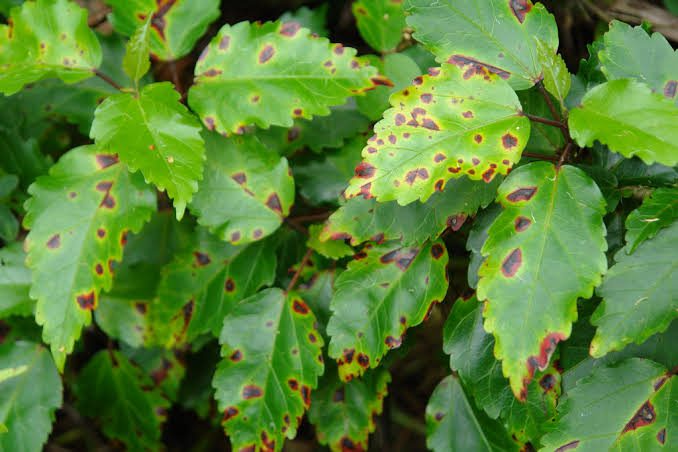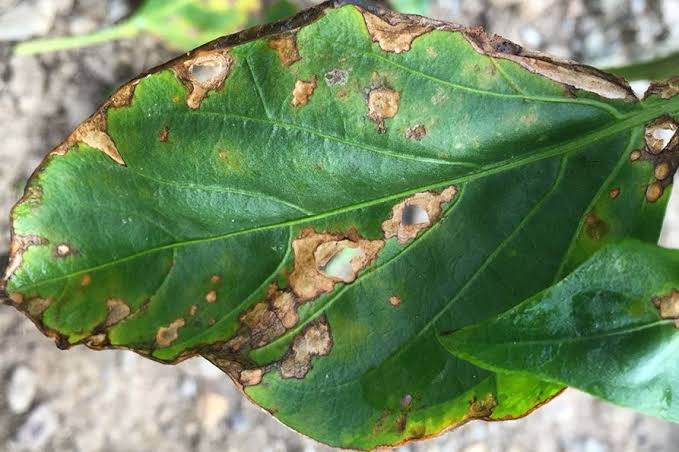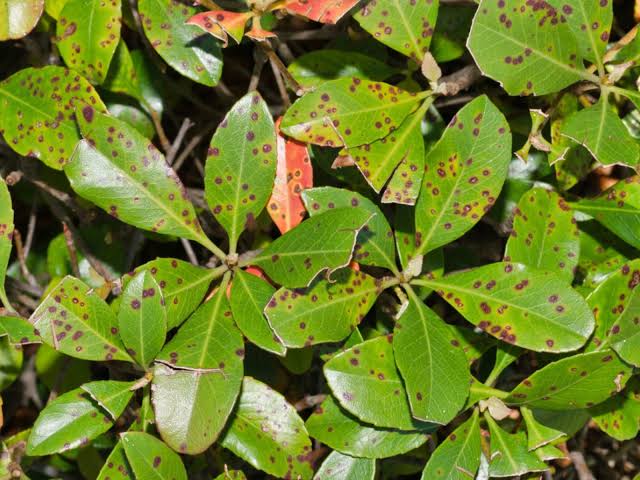Bacterial Leaf Spot is a plant disease caused by a bacterium scientifically named Xanthomonas campestris, this tiny microbe can be a troublemaker for various plants, affecting their leaves and overall health. Let’s delve into the details of this pesky issue and understand its impact on plants.
Plants, like people, can get sick, and one common ailment they face is Bacterial Leaf Spot. This illness is caused by the bacterium Xanthomonas campestris. This tiny bacterium can be a real headache for plants, especially those with broad leaves. Now, let’s explore what exactly happens when a plant falls victim to Bacterial Leaf Spot.
The first sign of trouble is usually the appearance of small, dark spots on the leaves. These spots may seem harmless at first, but they are indicative of an underlying bacterial invasion. As the disease progresses, these spots tend to grow and merge, forming larger lesions that can seriously impact the plant’s ability to photosynthesize.
Bacterial Leaf Spot spreads through water, often thriving in damp conditions. Rain or irrigation can play a role in its transmission, making it crucial to manage moisture levels around plants. Once the bacterium gains entry into the plant, it sets off a chain reaction of damage within the leaf tissues.
One of the remarkable aspects of Bacterial Leaf Spot is its ability to adapt to various plant species. It doesn’t discriminate much and can affect a wide range of crops, ornamental plants, and even some trees. This adaptability makes it a significant concern for farmers and gardeners alike.
To control Bacterial Leaf Spot, preventive measures are key. Practices like crop rotation, planting disease-resistant varieties, and maintaining good sanitation in the garden or field can go a long way in reducing the risk of infection. If the disease does strike, chemical treatments may be necessary, but these should be approached with care to minimize any negative impact on the environment.
Additionally, Bacterial Leaf Spot, caused by Xanthomonas campestris, is a plant disease that poses a threat to the vitality of various plants. Recognizing its early signs, understanding its transmission, and implementing preventive measures are crucial steps in managing this bacterial menace. Gardening and farming enthusiasts must stay vigilant to keep their leafy companions healthy and thriving.
Read Also: Economic Importance and Uses of Turkey Meat
Plants Affected by Bacterial Leaf Spot (Xanthomonas campestris)

Bacterial Leaf Spot can affect a wide variety of plants, ranging from crops to ornamental plants and even some trees. Some common plants susceptible to Bacterial Leaf Spot include tomatoes, peppers, lettuce, cabbage, beans, and cucumbers. Ornamental plants like roses, geraniums, and marigolds can also fall victim to this bacterial infection.
Furthermore, trees such as citrus trees and fruit-bearing trees like apple and pear trees may be affected. The ability of Xanthomonas campestris, the bacterium responsible for Bacterial Leaf Spot, to adapt to different plant species makes it a concern for both agricultural and horticultural settings.
The impact of Bacterial Leaf Spot on these plants varies, but it often manifests as dark spots on leaves, which can lead to significant damage if left unchecked. Plant enthusiasts and farmers should be aware of the susceptibility of these plants to Bacterial Leaf Spot and take proactive measures to prevent and manage the disease effectively.
Damages Caused by Bacterial Leaf Spot

Bacterial Leaf Spot can cause various damages to affected plants, impacting both their appearance and overall health. The primary consequences of this bacterial infection include:
1. Lesion Formation: The initial sign of Bacterial Leaf Spot is the development of small, dark spots on the leaves. These spots act as entry points for the bacterium, and as the infection progresses, they often grow and merge, forming larger lesions. These lesions disrupt the normal structure of the leaf and compromise its ability to carry out essential functions.
2. Reduced Photosynthesis: The lesions formed by Bacterial Leaf Spot can interfere with the process of photosynthesis, a vital function for plant growth. Photosynthesis is the plant’s way of converting sunlight into energy, and when this process is hindered, it can lead to reduced vigor, stunted growth, and a decline in overall plant health.
3. Premature Leaf Drop: In severe cases, Bacterial Leaf Spot can cause premature leaf drop. Infected leaves become weakened, making them more susceptible to falling off prematurely. This not only affects the aesthetic appeal of the plant but also diminishes its capacity to produce energy through photosynthesis.
4. Crop Yield Reduction: For crops like tomatoes, peppers, and beans, Bacterial Leaf Spot can result in a decrease in yield. The compromised health of the plant may lead to smaller fruits or diminished harvests, impacting agricultural productivity.
5. Spread to Surrounding Plants: Bacterial Leaf Spot is contagious, and if not addressed promptly, it can spread to nearby plants. This makes it important to manage infected plants effectively to prevent further contamination in the surrounding area.
Understanding the potential damages caused by Bacterial Leaf Spot underscores the importance of early detection and proactive measures. Implementing preventive strategies, such as maintaining good sanitation practices, using disease-resistant varieties, and managing moisture levels, can help mitigate the impact of this bacterial infection on plant health.
Read Also: Fire Blight (Rosaceae family): Description, Damages Caused, Control and Preventive Measures
Control and Preventive Measures

Controlling and preventing Bacterial Leaf Spot involves a combination of cultural practices, proper plant care, and, if necessary, the use of chemical treatments. Here are some effective measures to manage and prevent Bacterial Leaf Spot:
1. Crop Rotation: Rotate crops in the garden to disrupt the life cycle of the bacterium. Avoid planting susceptible crops in the same location year after year, as this can reduce the buildup of bacterial populations in the soil.
2. Use Disease-Resistant Varieties: Select plant varieties that have been bred for resistance to Bacterial Leaf Spot. Many crop varieties are available with improved resistance, offering a natural defense against the bacterium.
3. Sanitation Practices: Keep the garden or field clean by removing and destroying infected plant material. Regularly clean gardening tools, as they can harbor bacteria and contribute to the spread of the disease.
4. Proper Watering: Avoid overhead irrigation if possible, as wet foliage provides an ideal environment for the bacterium to thrive. Water the plants at the base to minimize moisture on the leaves. Additionally, water plants in the morning to allow foliage to dry during the day.
5. Good Air Circulation: Ensure proper spacing between plants to promote air circulation. Adequate ventilation helps to reduce humidity around the plants, creating an environment less favorable for Bacterial Leaf Spot development.
6. Copper-Based Sprays: Copper-based fungicides can be used as a preventive measure. These sprays create a protective barrier on the plant surface, hindering the entry of the bacterium. It’s important to apply these treatments before symptoms appear.
7. Biological Control: Some beneficial microorganisms, like certain strains of bacteria and fungi, can act as biological controls against Bacterial Leaf Spot. These can be introduced to the soil or applied as foliar sprays to suppress the growth of harmful bacteria.
8. Pruning Infected Areas: Promptly prune and remove infected plant parts to prevent the spread of Bacterial Leaf Spot. Be sure to disinfect pruning tools between cuts to avoid further contamination.
9. Quarantine: If you notice symptoms of Bacterial Leaf Spot on a plant, consider isolating it from healthy plants to prevent the spread of the disease. This temporary quarantine can help contain the infection and protect other plants.
Early detection and a proactive approach are key components of successful disease management strategies.
Frequently Asked Questions (FAQs) About Bacterial Leaf Spot (Xanthomonas campestris)
1. Q: What is Bacterial Leaf Spot?
A: Bacterial Leaf Spot is a plant disease caused by the bacterium Xanthomonas campestris. It manifests as dark spots on leaves and can affect a variety of plants, including crops and ornamental plants.
2. Q: How does Bacterial Leaf Spot spread?
A: Bacterial Leaf Spot spreads through water, often facilitated by rain or irrigation. The bacterium can enter plants through natural openings or wounds, leading to infection.
3. Q: Which plants are susceptible to Bacterial Leaf Spot?
A: Various plants can be affected, including crops such as tomatoes, peppers, lettuce, and beans, as well as ornamental plants like roses and geraniums. Some trees, including citrus and fruit-bearing trees, can also be susceptible.
4. Q: What are the symptoms of Bacterial Leaf Spot?
A: Early symptoms include small, dark spots on leaves, which may grow and merge into larger lesions. Infected plants may exhibit reduced photosynthesis, premature leaf drop, and overall decline in health.
5. Q: Can Bacterial Leaf Spot be prevented?
A: Yes, preventive measures include crop rotation, using disease-resistant varieties, maintaining good sanitation practices, proper watering techniques, and promoting air circulation around plants.
6. Q: How can I control Bacterial Leaf Spot in my garden?
A: Control measures involve pruning and removing infected plant parts, applying copper-based sprays as a preventive measure, implementing biological controls, and practicing proper sanitation to minimize the spread of the bacterium.
7. Q: Are there chemical treatments for Bacterial Leaf Spot?
A: In severe cases, chemical treatments such as copper-based fungicides may be used. However, these should be applied cautiously, considering potential environmental impacts.
8. Q: Can Bacterial Leaf Spot spread to other plants?
A: Yes, Bacterial Leaf Spot is contagious. If not managed promptly, the bacterium can spread to nearby plants, making it essential to isolate infected plants and practice good sanitation.
9. Q: Is Bacterial Leaf Spot harmful to humans?
A: No, Bacterial Leaf Spot typically affects only plants and does not pose a direct threat to humans. However, it can have economic implications for agriculture and horticulture.
10. Q: Can infected plants recover from Bacterial Leaf Spot?
A: In some cases, plants may recover if appropriate control measures are implemented early. However, severe infections can lead to permanent damage, and prevention is crucial for maintaining plant health.
Read Also: Membrane Geometries and Module Configuration
